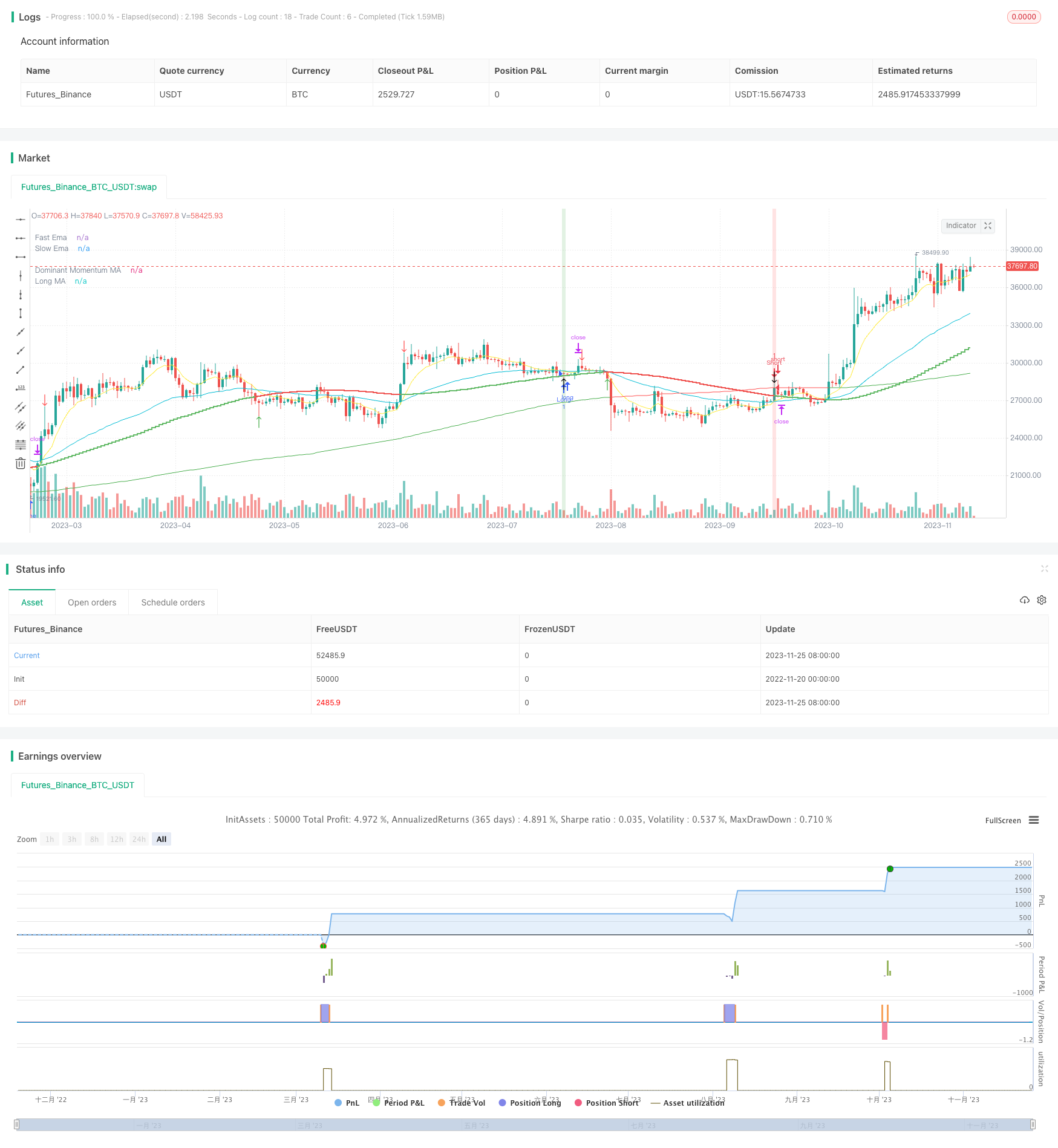
概述
该策略运用动量平滑移动平均线(ALMA)与两条不同参数设置的指数移动平均线(EMA)的交叉来产生交易信号。同时,策略还结合随机指数平滑移动平均线(Stochastic RSI)来避免过度买入卖出。
策略原理
动量ALMA线
策略使用ALMA作为主要判断价格趋势的指标。ALMA具有平滑价格数据的功能,可以过滤掉价格的随机波动。通过调整ALMA的周期、偏移值和sigma参数,可以使其更加灵敏或稳定。当价格上涨时,ALMA会呈现绿色,价格下跌时会呈现红色。
快慢EMA线交叉
策略使用长度不同的两条EMA线。当快速EMA线向上穿过慢速EMA线时,产生买入信号;当快速EMA线向下穿过慢速EMA时,产生卖出信号。EMA交叉具有比较好的趋势判断能力。快慢EMA的周期可以通过参数调整,以适应不同的交易品种和周期。
Stochastic RSI
Stochastic RSI指标的作用是避免在超买超卖区域发出交易信号。它结合RSI和Stochastic两个指标的优点,可以更好判断巅峰和低谷区域。在Stochastic RSI指标超买或超卖时,该策略会取消原有的多头或空头订单。
策略优势分析
顺势操作,抓住趋势
策略充分利用EMA交叉判定价格趋势方向的优势,配合ALMA指标来定位主要的多头和空头机会,实现顺势交易。
参数可调整,适应性强
EMA周期、ALMA参数等都提供了可调整的空间,用户可以根据自己的需要优化参数,使策略更好适应不同市场环境。
有止损停利机制
策略内置了止损停利设定。采用浮动止损可以减少止损被追杀的概率;有利润取得设置可以锁定盈利,避免把利润吐出。
风险分析
趋势判断错误
在复杂的行情中,EMA和ALMA线可能会发出错误信号。这时就要依赖止损来控制损失。
参数不当
如果参数设置不当,EMA和ALMA线就不能正确发挥作用,会增加交易风险。需要测试和优化来选择最佳参数组合。
策略优化方向
测试优化EMA和ALMA的参数设置,选择最优参数。
结合其他指标过滤信号,避免错误信号带来损失。例如MACD,KDJ等。
优化止损幅度,在控制风险和获利之间找到平衡。
测试不同的品种和周期参数,使策略适用于更多市场。
总结
该策略整体来说是一个简单实用的趋势跟踪策略。它利用EMA交叉判定趋势方向,ALMA指标定位加仓点位,Stochastic RSI避免超买超卖的风险,同时设置了止损和止盈来控制风险。通过参数调整和指标优化,该策略可以获得较好的效果。它既容易理解和使用,也有一定的自适应能力。
/*backtest
start: 2022-11-20 00:00:00
end: 2023-11-26 00:00:00
period: 1d
basePeriod: 1h
exchanges: [{"eid":"Futures_Binance","currency":"BTC_USDT"}]
*/
//@version=5
////Arranged by @ClassicScott
//Strategy Created by @CheatCode1
strategy('ALMA/EMA Strategy', shorttitle='ALMA/EMA Strategy', overlay=true )
////Source Selection & ALMA Variables
//Dominant Momentum ALMA
dsource = input.source(close, title='Source', group='Dominant ALMA')
dperiod = input.int(title='Period', defval=130, group='Dominant ALMA')
doffset = input.float(title='Offset', step=0.025, defval=0.775, group='Dominant ALMA')
dsigma = input.float(title='Sigma', step=0.5, defval=4.5, group='Dominant ALMA')
dalma = ta.alma(dsource, dperiod, doffset, dsigma)
dalma_up_color = input.color(#66bb6a, 'Going Up!', group='Dominant ALMA', inline = '1')
dalma_down_color = input.color(#ef5350, 'Going Down :(', group='Dominant ALMA', inline = '1')
dcolor = close[1] > dalma ? dalma_up_color : dalma_down_color
////ALMA Plots
plot(dalma, color=dcolor, style=plot.style_stepline, linewidth=2, title='Dominant Momentum MA')
//Strategy by @CheatCode1 //Strategy by @CheatCode1 //Strategy by @CheatCode1 //Strategy by @CheatCode1 //Strategy by @CheatCode1 //Strategy by @CheatCode1 //Strategy by @CheatCode1 //Strategy by @CheatCode1 //Strategy by @CheatCode1 //Strategy by @CheatCode1 //Strategy by @CheatCode1 //Strategy by @CheatCode1
//Strategy by @CheatCode1 //Strategy by @CheatCode1 //Strategy by @CheatCode1 //Strategy by @CheatCode1 //Strategy by @CheatCode1 //Strategy by @CheatCode1 //Strategy by @CheatCode1 //Strategy by @CheatCode1 //Strategy by @CheatCode1 //Strategy by @CheatCode1 //Strategy by @CheatCode1 //Strategy by @CheatCode1
cheatcode = input.bool(true, '-----------CHEATC0DE1------------', group = 'Strategy Inputs', confirm = true)
//Variable Declerations/Plot Assingments
inp1 = input.int(49, 'Slow Ema Length', 1, 100, group = 'Strategy Inputs', confirm = true)
inp2 = input.int(9, 'Fast Ema Length', 1, 200, group = 'Strategy Inputs', confirm = true)
inp3 = int(200)
sma1 = ta.sma(close, inp3)
ema1 = ta.ema(close, inp1)
ema2 = ta.ema(close, inp2)
eplot1 = plot(ema1, 'Slow Ema', color.aqua, 1, plot.style_linebr)
eplot2 = plot(ema2, 'Fast Ema', color.yellow, 1, plot.style_linebr)
splot1 = plot(sma1, 'Long MA', close[1] < sma1 ? color.red:color.green, 1, plot.style_line, display = display.none)
cross1 = ta.crossover(ema1, ema2)
cross2 = ta.crossunder(ema1, ema2)
plotchar(cross1, '', '↑', location.belowbar, close[1] > dalma and dalma > sma1 ? na:color.green, size = size.normal, editable = false)
plotchar(cross2, '', '↓', location.abovebar, close[1] < dalma and dalma < sma1 ? na:color.red, size = size.normal, editable = false)
bgcolor(cross1 and close[1] > dalma ? color.new(color.green, 80):cross2 and close[1] < dalma ? color.new(color.red, 80):na)
valueL = ta.valuewhen(cross1 and close[1] > dalma, close, 0)
valueS = ta.valuewhen(cross2 and close[1] < dalma, close, 0)
//Entries
if cross1 and close[2] > dalma[2] and close[1] > dalma[1]
strategy.entry('Long', strategy.long)
if cross2 and close[2] < dalma[2] and close[1] < dalma[1]
strategy.entry('Short', strategy.short)
//StochRsi
smoothK = input.int(3, "K", minval=1)
smoothD = input.int(15, "D", minval=1)
lengthRSI = input.int(14, "RSI Length", minval=1)
lengthStoch = input.int(8, "Stochastic Length", minval=1)
src = input(close, title="RSI Source")
rsi1 = ta.rsi(src, lengthRSI)
k = ta.sma(ta.stoch(rsi1, rsi1, rsi1, lengthStoch), smoothK)
d = ta.sma(k, smoothD)
//Cancellations
if k > 75
strategy.cancel('Long')
if k < 25
strategy.cancel('Short')
//Closures
if ta.crossunder(k, d) and k > 92
strategy.close('Long')
if ta.crossover(k,d) and k < 8
strategy.close('Short')
//Exit Percents
takeP = input.float(3, title='Take Profit', group = 'Take Profit and Stop Loss') / 100
stopL = input.float(5.49, title = 'Stop Loss', group = 'Take Profit and Stop Loss')/100
// Pre Directionality
Stop_L = strategy.position_avg_price * (1 - stopL)
Stop_S = strategy.position_avg_price * (1 + stopL)
Take_S= strategy.position_avg_price * (1 - takeP)
Take_L = strategy.position_avg_price * (1 + takeP)
//Post Excecution
if strategy.position_size > 0
strategy.exit("Flat", limit=Take_L, stop = Stop_L)
if strategy.position_size < 0
strategy.exit("Flat", limit=Take_S, stop = Stop_S)